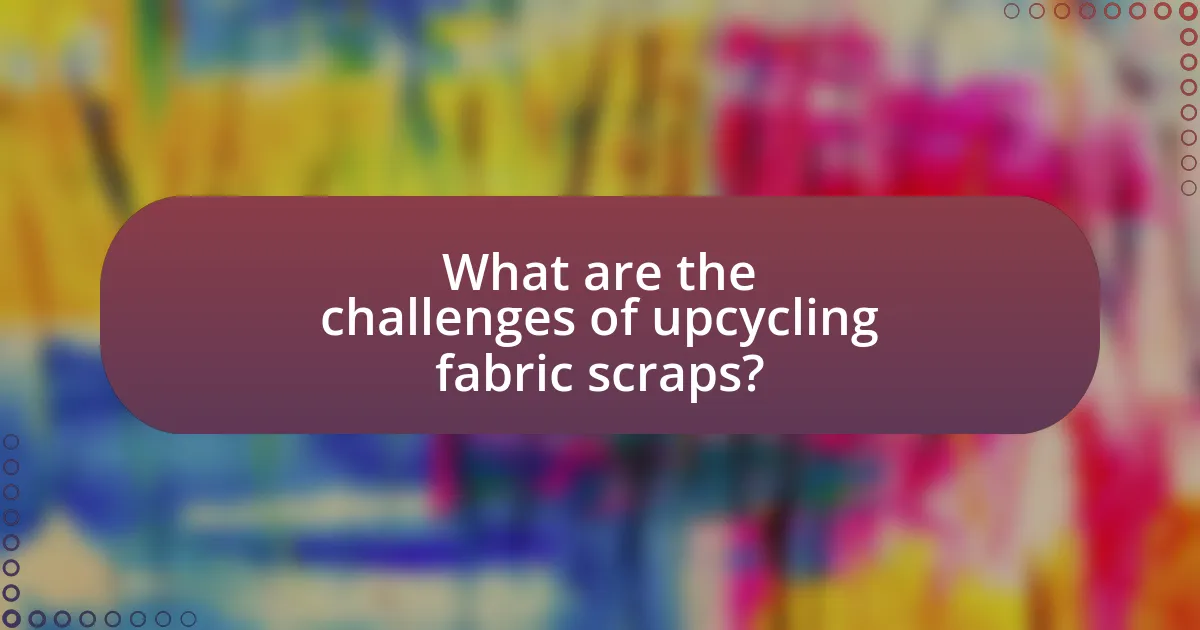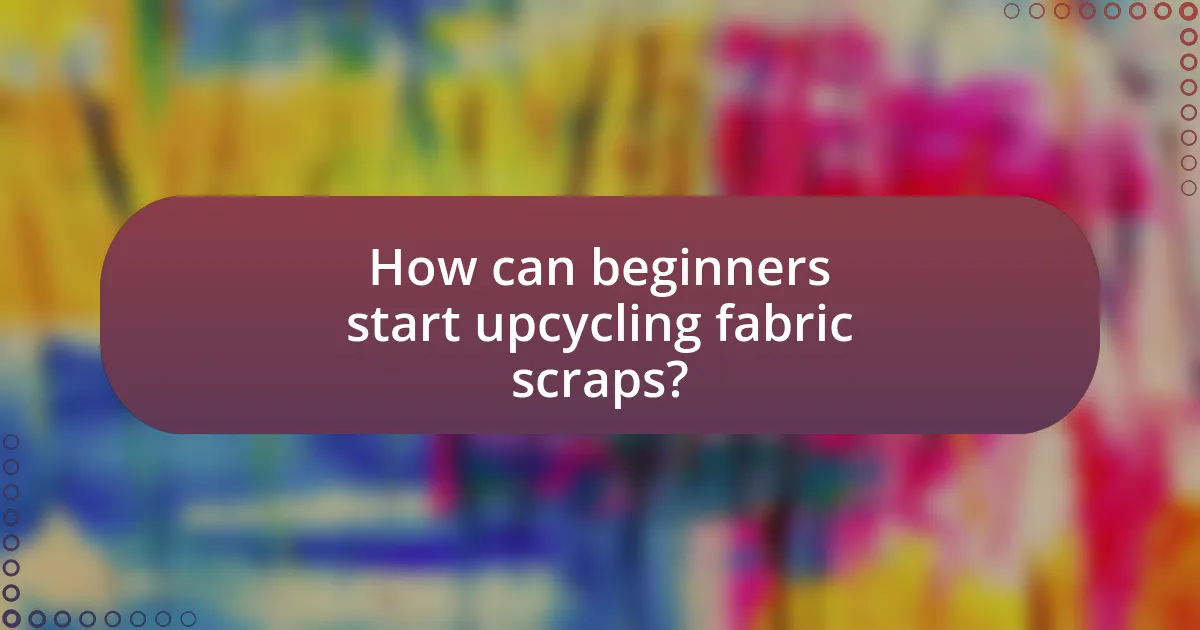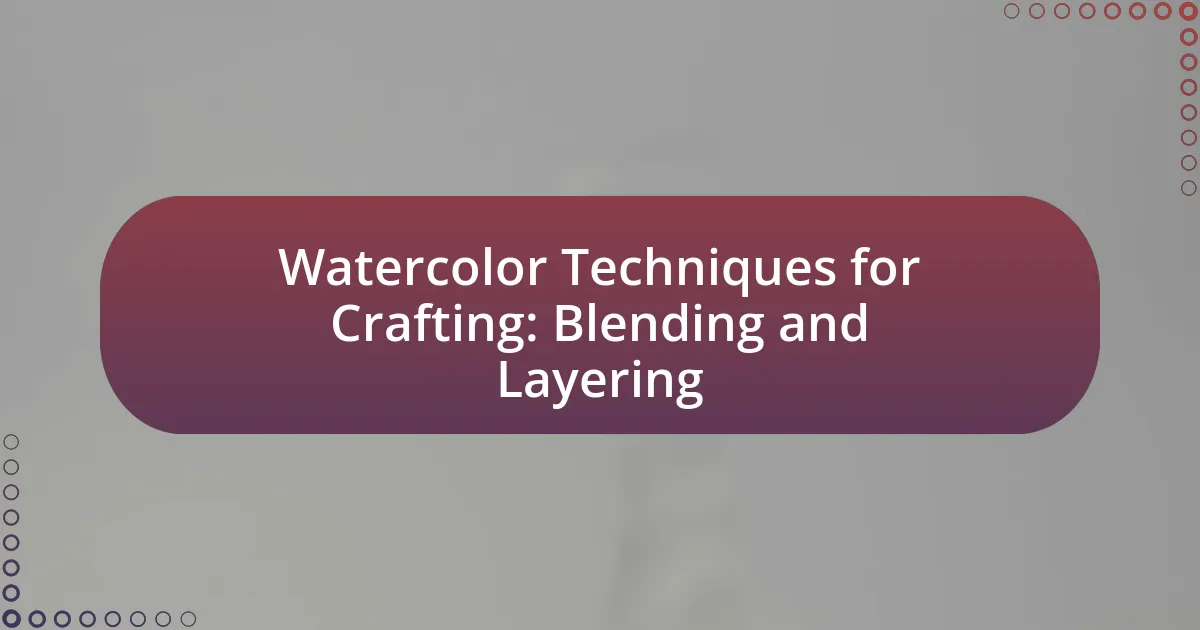Upcycling fabric scraps involves creatively repurposing leftover textile materials into new, functional items, thereby promoting sustainability and reducing waste in the fashion industry. This article explores the environmental benefits of upcycling, including its role in minimizing landfill contributions and resource consumption. It discusses various types of fabric suitable for upcycling, creative sewing techniques such as patchwork and appliqué, and innovative project ideas for beginners. Additionally, the article addresses challenges faced in upcycling and offers practical tips for enhancing the upcycling experience, ultimately contributing to a more sustainable approach in crafting and fashion.

What is Upcycling Fabric Scraps?
Upcycling fabric scraps is the process of creatively repurposing leftover pieces of fabric into new, functional items. This practice not only reduces waste but also promotes sustainability in the textile industry by extending the life cycle of materials. According to a report by the Ellen MacArthur Foundation, upcycling can significantly decrease the environmental impact of fashion by minimizing landfill contributions and resource consumption.
How does upcycling fabric scraps contribute to sustainability?
Upcycling fabric scraps contributes to sustainability by reducing waste and minimizing the environmental impact of textile production. When fabric scraps are repurposed, they divert materials from landfills, where textiles can take years to decompose, and decrease the demand for new fabric production, which is resource-intensive. According to the Environmental Protection Agency, in 2018, approximately 11.3 million tons of textile waste were generated in the United States alone, highlighting the importance of upcycling as a method to mitigate this issue. By transforming discarded materials into new products, upcycling not only conserves resources but also promotes a circular economy, where materials are reused and recycled, ultimately leading to a more sustainable fashion industry.
What are the environmental benefits of upcycling fabric scraps?
Upcycling fabric scraps significantly reduces environmental waste by diverting materials from landfills. This process conserves resources, as it minimizes the need for new raw materials, thereby decreasing the environmental impact associated with textile production, which includes water usage, chemical pollution, and energy consumption. According to the Ellen MacArthur Foundation, the fashion industry is responsible for 92 million tons of waste annually, highlighting the importance of upcycling in mitigating this issue. Additionally, upcycling fabric scraps can lower carbon emissions by reducing the demand for new textiles, which often involve energy-intensive manufacturing processes.
How does upcycling reduce textile waste?
Upcycling reduces textile waste by transforming discarded fabrics into new, usable products, thereby preventing these materials from ending up in landfills. This process not only extends the lifecycle of textiles but also minimizes the demand for new fabric production, which is resource-intensive. According to the Environmental Protection Agency, in 2018, approximately 11.3 million tons of textile waste were generated in the United States alone, highlighting the significant impact of upcycling in addressing this issue. By creatively reusing fabric scraps, upcycling contributes to a circular economy, reducing overall waste and promoting sustainable practices in the fashion industry.
What types of fabric scraps can be upcycled?
Various types of fabric scraps can be upcycled, including cotton, linen, wool, silk, and synthetic materials like polyester. Cotton scraps are particularly versatile due to their durability and ease of handling, making them suitable for projects such as patchwork quilts and tote bags. Linen, known for its strength and breathability, can be transformed into home decor items like cushion covers. Wool scraps can be used for felting projects or as insulation in crafts. Silk, while delicate, can be repurposed into accessories like scarves or hair ties. Synthetic fabrics like polyester can be upcycled into functional items such as reusable shopping bags. Each type of fabric scrap offers unique properties that lend themselves to various creative sewing techniques, reinforcing the potential for upcycling in sustainable fashion practices.
Which fabrics are most suitable for upcycling?
Cotton, denim, and wool are the most suitable fabrics for upcycling due to their durability and versatility. Cotton is widely available and can be easily transformed into various items, while denim’s strength allows for creative repurposing into bags or clothing. Wool, known for its insulating properties, can be upcycled into warm accessories or blankets. These fabrics are favored in upcycling projects because they can withstand multiple washes and maintain their integrity, making them ideal for new creations.
How can different fabric textures affect the upcycling process?
Different fabric textures significantly influence the upcycling process by affecting the ease of sewing, the final aesthetic, and the durability of the finished product. For instance, thicker fabrics like denim or canvas provide structural integrity, making them suitable for items like bags or home decor, while lighter fabrics such as cotton or silk may require more delicate handling and can create softer, flowing designs. Additionally, varying textures can create visual interest and contrast in upcycled projects, enhancing their appeal. Research indicates that the compatibility of fabric textures can impact the longevity of seams and overall durability, as mismatched textures may lead to issues like fraying or uneven wear over time.
What creative sewing techniques can be used for upcycling fabric scraps?
Creative sewing techniques for upcycling fabric scraps include patchwork, appliqué, and fabric weaving. Patchwork involves sewing together various fabric pieces to create a cohesive design, often used in quilts and bags. Appliqué entails stitching smaller pieces of fabric onto a larger base fabric to form shapes or patterns, enhancing visual interest. Fabric weaving can be achieved by cutting scraps into strips and interlacing them to create new textile pieces, such as rugs or wall hangings. These techniques not only reduce waste but also allow for unique, personalized creations.
How can patchwork techniques enhance upcycled projects?
Patchwork techniques can enhance upcycled projects by allowing the creative combination of various fabric scraps into cohesive, functional designs. This method not only maximizes the use of leftover materials, reducing waste, but also adds visual interest and uniqueness to each project. For instance, a study by the University of California found that incorporating diverse textures and colors through patchwork can significantly increase the aesthetic appeal of upcycled items, making them more desirable in the market. Additionally, patchwork techniques promote sustainability by encouraging the reuse of materials, aligning with eco-friendly practices in fashion and home decor.
What role does appliqué play in upcycling fabric scraps?
Appliqué plays a crucial role in upcycling fabric scraps by allowing the transformation of small pieces of fabric into decorative elements on new projects. This technique enhances the aesthetic appeal of items such as clothing, bags, and home decor while effectively utilizing leftover materials, thereby reducing waste. By incorporating appliqué, crafters can creatively express their individuality and repurpose fabric that might otherwise be discarded, contributing to sustainable practices in the textile industry.

What are the challenges of upcycling fabric scraps?
The challenges of upcycling fabric scraps include limited material availability, inconsistent fabric quality, and the need for creative design solutions. Limited material availability arises because fabric scraps may not provide enough quantity for larger projects, making it difficult to create cohesive items. Inconsistent fabric quality can lead to difficulties in achieving uniformity in texture and durability, as different scraps may have varying properties. Additionally, the need for creative design solutions is essential, as upcyclers must find innovative ways to combine disparate pieces into functional and aesthetically pleasing products, which can be time-consuming and require advanced sewing skills.
How can one overcome common obstacles in upcycling?
To overcome common obstacles in upcycling, one can focus on enhancing skills, sourcing materials effectively, and fostering creativity. Developing sewing techniques through practice and tutorials can address skill-related challenges, while establishing connections with local fabric stores or online marketplaces can ensure a steady supply of materials. Additionally, engaging in brainstorming sessions or joining upcycling communities can inspire innovative ideas, thus overcoming creative blocks. Research indicates that community involvement significantly boosts motivation and resourcefulness in upcycling projects, as seen in studies highlighting the benefits of collaborative creativity in sustainable practices.
What tools and materials are essential for successful upcycling?
Essential tools and materials for successful upcycling include a sewing machine, fabric scissors, pins, a rotary cutter, cutting mat, and various fabric scraps. The sewing machine allows for efficient stitching, while fabric scissors ensure clean cuts. Pins are crucial for holding pieces together during assembly, and a rotary cutter paired with a cutting mat provides precision in cutting fabric. Various fabric scraps, which can be sourced from old clothing or leftover materials, serve as the primary medium for upcycling projects. These tools and materials collectively facilitate the transformation of discarded items into new, functional creations, supporting sustainable practices in crafting.
How can skill levels affect the upcycling process?
Skill levels significantly affect the upcycling process by determining the complexity and quality of the final product. Individuals with higher skill levels can execute intricate designs, utilize advanced sewing techniques, and effectively troubleshoot issues that arise during the upcycling process. For instance, a skilled sewer can transform fabric scraps into high-quality garments or home decor items, while a beginner may struggle with basic stitching or fabric manipulation. Research indicates that experienced crafters often achieve a higher rate of satisfaction and success in their projects, as they can better envision and realize creative possibilities with the materials at hand.
What are some innovative projects for upcycling fabric scraps?
Innovative projects for upcycling fabric scraps include creating patchwork quilts, fabric baskets, and reusable shopping bags. Patchwork quilts utilize various fabric pieces to form a cohesive design, promoting sustainability by repurposing scraps. Fabric baskets can be sewn from leftover materials, providing functional storage solutions while reducing waste. Reusable shopping bags made from fabric scraps not only serve an eco-friendly purpose but also encourage a reduction in single-use plastic consumption. These projects exemplify how fabric scraps can be transformed into practical and aesthetically pleasing items, contributing to a circular economy in the textile industry.
How can upcycled fabric scraps be transformed into home décor items?
Upcycled fabric scraps can be transformed into home décor items by sewing them into various products such as cushions, wall hangings, and table runners. This process involves selecting complementary fabric pieces, cutting them into desired shapes, and stitching them together to create unique designs. For instance, patchwork techniques can be used to combine different patterns and colors, resulting in visually appealing items that enhance interior spaces. Additionally, studies show that upcycling reduces textile waste, with the Environmental Protection Agency reporting that in 2018, 11.3 million tons of textile waste were generated in the U.S. alone. This practice not only promotes sustainability but also allows for personalized home décor that reflects individual style.
What are some fashion items that can be created from fabric scraps?
Fashion items that can be created from fabric scraps include patchwork bags, scrunchies, headbands, and quilts. These items utilize leftover fabric pieces, promoting sustainability in fashion. For instance, patchwork bags combine various fabric scraps into a unique design, while scrunchies and headbands can be made from small fabric remnants, reducing waste. Quilts often repurpose larger scraps, showcasing creativity and resourcefulness in textile use. This practice not only minimizes environmental impact but also encourages innovative design in the fashion industry.

How can beginners start upcycling fabric scraps?
Beginners can start upcycling fabric scraps by first collecting various fabric remnants and then selecting simple projects such as patchwork quilts, tote bags, or fabric coasters. These projects require minimal sewing skills and allow for creativity in combining different patterns and colors. According to a study by the Ellen MacArthur Foundation, upcycling can significantly reduce textile waste, making it an environmentally friendly practice. By engaging in these projects, beginners not only learn sewing techniques but also contribute to sustainability efforts.
What are the first steps to begin upcycling fabric scraps?
To begin upcycling fabric scraps, first gather and sort your fabric remnants by type, color, and size. This organization allows for easier selection and planning of projects. Next, identify potential projects that can utilize these scraps, such as patchwork quilts, tote bags, or decorative items. Researching tutorials or patterns specific to your chosen projects can provide guidance and inspiration. Finally, prepare your workspace with necessary tools like scissors, sewing machines, and threads to facilitate the upcycling process efficiently.
How can one gather and organize fabric scraps effectively?
To gather and organize fabric scraps effectively, one should first designate a specific storage area, such as bins or drawers, to keep the scraps sorted by size, color, or type. This method allows for easy access and identification of materials when needed. Additionally, using clear containers can enhance visibility, making it simpler to locate specific scraps. Research indicates that organized storage systems can improve efficiency in crafting and reduce waste, as noted in studies on workspace organization in creative environments.
What beginner-friendly projects are recommended for new upcyclers?
Beginner-friendly projects recommended for new upcyclers include creating tote bags from old t-shirts, making patchwork quilts from fabric scraps, and transforming denim jeans into stylish aprons. These projects are accessible because they require minimal sewing skills and utilize readily available materials. For instance, t-shirt tote bags can be made without any sewing by simply cutting and tying the fabric, while patchwork quilts allow for creativity with various fabric pieces, making them ideal for beginners to practice sewing techniques.
What tips can enhance the upcycling experience?
To enhance the upcycling experience, focus on selecting versatile fabric scraps that can be easily combined into new projects. Using a variety of textures and colors can create visually appealing results, as studies show that diverse materials stimulate creativity and innovation in crafting. Additionally, organizing scraps by size and type can streamline the process, making it easier to find suitable pieces for specific projects. This method not only saves time but also encourages experimentation, leading to unique and personalized creations.
How can one develop a personal style in upcycling projects?
To develop a personal style in upcycling projects, one should focus on identifying unique preferences and incorporating them into designs. This can be achieved by experimenting with various materials, colors, and techniques that resonate personally, allowing for a distinctive aesthetic. For instance, selecting specific fabric patterns or textures that reflect individual tastes can enhance the uniqueness of each project. Additionally, keeping a visual journal of inspirations and completed projects can help track personal evolution and style preferences over time. Engaging with communities, both online and offline, can also provide feedback and new ideas, further refining one’s personal style in upcycling.
What resources are available for learning more about upcycling techniques?
Books, online courses, and community workshops are valuable resources for learning upcycling techniques. Notable books include “Upcycling: Create Beautiful Things with the Stuff You Already Have” by Danny Seo, which provides practical projects and inspiration. Online platforms like Skillshare and Udemy offer courses specifically focused on upcycling, teaching various methods and creative applications. Additionally, local community centers often host workshops that allow hands-on experience with upcycling fabric scraps, fostering skills through direct instruction and collaboration. These resources collectively enhance understanding and application of upcycling techniques.





